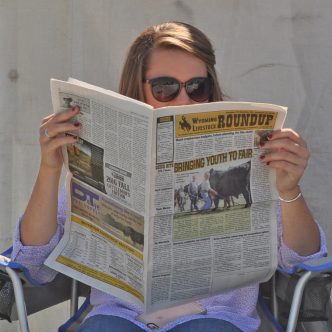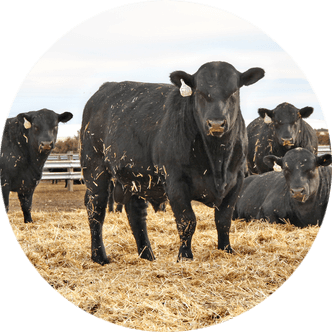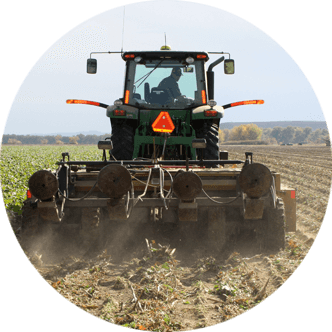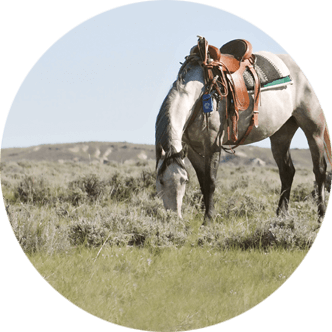Cattle and Quarter Horses: Spratt family embodies spirit of Wyoming ranching
TJ and Jennie Spratt are the fifth generation on their family ranch near Lysite, and their daughter Coralee and her husband Seth Andersen are the sixth.
Originally part of the old Matador Ranch – a huge, historic operation established in 1879 with locations in Texas, Montana and Wyoming – the ranch today boasts a colorful history and continues to thrive under the care of the Spratt and Andersen families.
According to Jennie, the Matador’s Wyoming ranch was massive, and the piece they run on today was just a small section known as the Linn Place.
TJ’s parents purchased the ranch – located about 60 miles from Riverton and 80 miles from Casper – in the early 1980s, and TJ and Jennie have resided here since they were married in 1989.
Cattle operation
Today, the Spratt and Andersen families run a herd of crossbred cattle and calve out about 250 heifers a year on the high-desert country of Fremont County.
Due to the rugged location, the family keeps all of their own replacement heifers, which seem to be better adapted to the tough environment, short grass and limited water.
“We keep all of our heifers, send them to the feedlot and sort them later,” Jennie explains. “We turn out about 350 to 400 to be bred to Wagyu bulls, and we have some friends who buy the late calvers.”
Jennie notes heifers are bred to Wagyu bulls leased from Agri-Beef of American Falls, Idaho.
“Wagyu are becoming more popular, but we started doing it back when it wasn’t popular,” Jennie shares. “We’d breed 200 heifers, and back in those early days it was just my husband and I who calved them out. One year we had to pull more than half of the calves, even though we were using low birthweight bulls.”
“My mom was still working at the Fort Keogh Livestock and Range Research Laboratory in Miles City, Mont. at the time and she told us one of their studies showed more of the weight and size of the calf is determined by the dam than the bull, but if the calf is too big, the bull always gets blamed for it,” she continues.
Jennie notes her dad encouraged her to look into the Wagyu breed because they tend to throw smaller calves and are good to use on heifers.
“It sure solved our calving problems,” she admits. “We still occasionally have to pull a calf but not very often, and these little toughies are survivors. They get right up and will suck anything. I can’t remember what year we started using Wagyu, but it’s worked really well for us.”
The family also utilizes Black Angus and Hereford genetics.
“We have mostly Black Angus cattle, but I really like Herefords,” Jennie shares. “We started using Hereford bulls on the Angus cows many years ago, and it makes for a really good cross. Now we are moving back toward Angus a little more, because buyers always want black cattle even though they are all the same under the hide.”
Jennie notes she likes Herefords for their easy-going temperament and ability to get out and go. The first Hereford bull on the ranch was a Line One Hereford from Fort Keogh.
“Where we live, our cattle run on high-desert country, and they have to travel a lot – it’s a long way to water – so we generally don’t keep our bulls more than four years,” Jennie explains. “As they get older, they get so big they don’t like to travel as far, but that first Line One bull trotted everywhere. He was the best bull. The Herefords are so easy to get along with.”
Now, the Spratt and Andersen families source their purebred Hereford bulls from Tom and Marina Hadley of Wheatland and their Angus bulls from Bart Aby of Laurel, Mont.
Quarter Horses
In addition to running cattle, the Spratt and Andersen families also raise and train their own ranch horses. In fact, Jennie jokes they only run cows because they like the horse side of ranching.
“We have 15 broodmares and raise and train our own ranch horses. TJ has never bought a horse except our stud, and heʼs 62 years old now so we’ve raised a lot of horses,” she says. “My father-in-law started the breeding program and still has a say in breeding decisions. He’s been at it so long, he’s pretty good at it.”
Early on, the horse herd started out with Hancock and Blue Valentine bloodlines, then turned to Doc Bar.
“Later, we got a Freckles Playboy stud out of a Zan Parr Bar mare we loved. Then we used a Driftwood stud,” Jennie says. “We’ve had a Doc’s Hickory stud and a Blue Light Ike stud, and now we’ve got a Smooth Guy stud.”
Off of the ranch, Jennie and TJ like to compete in the arena, and Jennie specifically enjoys breakaway, barrel racing and team roping.
“TJ and I are very competitive and have enjoyed team roping together,” she says. “Here on the ranch, I don’t ride any of the colts but the kids and my husband do. They ride them for the first 10 years, and I take them for the next 10.”
Additionally, Jennie notes all of the cattle work is done with horses, and the family particularly enjoys rope branding using a Nordfork.
She shares, “We have a branding trailer we set up in the middle of the branding corral, with two forks on each side. This year we did 640 head of calves in three hours.”
“We have a lot of ropers and fast folks on the ground doing the branding and vaccinating. Everybody knows what they need to do,” she adds. “With a good crew and good horses it all goes smoothly.”
Heather Smith Thomas is a corresponding writer for the Wyoming Livestock Roundup. Send comments on this article to roundup@wylr.net.





